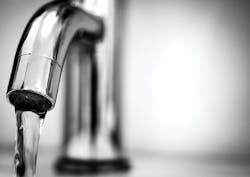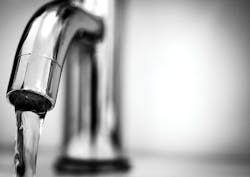By Angela Godwin
EPA is expected to issue proposed revisions to the Lead and Copper Rule this year, the rule’s first major revision in more than a decade.
The legislative landscape of the water industry is likely to be dominated by a few familiar issues in 2018, and chief among them is funding for water and wastewater infrastructure. At the time of this writing, Congress has passed a continuing resolution (CR) to keep the government funded through January 19, 2018, until it can agree on a FY18 appropriations bill. The CR maintains FY17 level funding for the two major drinking water and wastewater infrastructure funding mechanisms, the Drinking Water State Revolving Fund (SRF) and the Clean Water SRF programs ($863 million and $1.3 billion, respectively).
“On the SRF programs, we’ve seen over the last several years a kind of flatlining of the funding amounts,” said Steven Dye, director of legislative affairs for the Water Environment Federation (WEF). “But we’ve got good support in Congress from both Democrats and Republicans for both SRF programs.”
A coalition of water associations, including WEF, the American Water Works Association (AWWA), the National Association of Clean Water Agencies (NACWA), and others, has been pushing hard over the past several years for additional increases. One of the joint “asks” coming out of the water associations’ annual Water Week and national water policy fly-in last spring was to double FY18 SRF program funding to $1.8 billion for drinking water and $2.8 billion for clean water.
During his campaign, President Donald Trump had called for tripling the SRF, Dye noted. “But that was during the campaign,” he said. Since coming into office, the president called for only very modest increases in the SRF in his FY18 budget proposal. But Dye sees that as a positive. “He was showing support for the SRF program,” he pointed out.
Nathan Gardner-Andrews, chief advocacy officer for NACWA, agreed. “The good news is that through the budget process in Congress, we’ve seen both the House and the Senate come out in support of at least maintaining level funding.” With other Environmental Protection Agency (EPA) programs seeing significant cuts, this is a particularly poignant show of commitment by both the administration and Congress, he suggested.
Given the current political climate, however, it’s difficult to speculate on how the congressional cookie might crumble regarding final FY18 appropriations, but both Dye and Gardner-Andrews are cautiously optimistic that SRF funding will at least remain level with FY17 amounts.
Regardless, water associations are moving full steam ahead with plans to increase their funding requests for FY19, asking for $3 billion for each of the SRF programs. “We’re also pushing in the year ahead for reauthorization of the SRF programs,” Dye added. “They went through their initial authorization period when they were enacted and they continue to be funded robustly year in and year out by Congress because they recognize the value of the SRF programs — but technically, neither program is currently authorized.”
A reauthorization could also entail a few tweaks to the SRF program “that will help make it more efficient,” Dye said. These might include streamlining of the application process to make it more uniform across states. “This would make it as easy as possible for utilities to apply for and receive SRF funding,” he said.
It’s possible that reauthorization of the SRF programs could be included in the next Water Resources Development Act (WRDA) bill, something that may be looming on the legislative horizon in 2018. “Both the House and Senate have expressed interest in keeping WRDA on a two-year cycle,” said Gardner-Andrews. They did a good job in both 2014 and 2016, he noted, and WRDA always provides a good vehicle to advance important water policy concepts — such as integrative planning and affordability, two issues Gardner-Andrews sees as particularly pressing in the water sector.
There could be a snag, however. “Legislative calendars tend to get scrambled in an election year,” he said, narrowing the timeframe in which to address big-ticket items like WRDA. It could be late spring before “we’ll get a sense of whether any of these things have a realistic chance of actually moving forward or not.”
WIFIA Program
In 2017, the water industry saw a new stream of funding begin to trickle into the market courtesy of the Water Infrastructure Finance and Innovation Act (WIFIA). “We have been very pleased with the job that EPA has done to stand this program up,” said Tracy Mehan, executive director of government affairs at AWWA. “They staffed up, they brought in expertise from other agencies that they’ve needed. And so, praise goes to that effort.”
This first round of the WIFIA program drew significant interest from the water and wastewater sector. “In 2017, prospective borrowers submitted 43 letters of interest requesting approximately $6 billion in loans for water infrastructure projects across the country,” an EPA spokesperson told WaterWorld. “From these letters of interest, twelve projects were selected to apply for WIFIA loans.”
“One of the things that was most interesting with this first round of WIFIA,” noted Gardner-Andrews, “was the great diversity in the types of utilities that applied for it and that got awarded.” It was a good mix of drinking water projects and clean water projects, he said, along with private entities and public. “So, I think it’s really working well, the way it was intended to.”
It’s also proving to be a sound investment. With the initial $30 million in funding from Congress, the WIFIA program is expected to be able to leverage $2.3 billion in loans, “which will equal $5.1 billion in projects,” said Dye.
“And it’s a good deal for taxpayers,” added Mehan. In looking at the credit worthiness of the 12 selected projects, EPA determined that the leverage ratio of how much will be returned on every dollar invested is 92:1. This far exceeded expectations, Mehan said. “We had thought it would be 50 or 60:1, so this is really fantastic. They are getting a big bang for the buck in infrastructure with the WIFIA program.”
At this time, WIFIA is still a pilot program but there has been legislation introduced to make it permanent. “We’re interested in that,” said Mehan. “But we definitely want to see the initial awards get out there and see how it plays out.”
When WIFIA was first unveiled, there was some initial concern that it could adversely impact the SRF funding programs, but those fears do not appear to have been realized, said Mehan. “Nothing that the administration or Congress has proposed has shown that there is any competition for — or detriment to — one side or the other, whether it’s WIFIA or the SRF program,” he said.
In fact, the two programs target different needs. “The SRFs are focused on compliance around the Clean Water Act and Safe Drinking Water Act,” Dye explained. Although WIFIA has some of that in it, Dye said, “it’s also meant to address some of the other more complex challenges that communities have with infrastructure — like growth, water security and innovative technologies.” Such projects tend to be larger and more expensive, and also more challenging for communities to obtain funding for, he explained. “We want to keep emphasizing that with Congress. When they are providing funding, it’s important that they provide full funding for both the SRF programs and the WIFIA program.” The underlying message to Congress, Dye said, is that the need for water infrastructure funding and financing far exceeds the available sources of funding, “so let’s not rob Peter to pay Paul. Let’s make sure that both programs — as well as other programs — are fully funded and working together.”
Water associations are keeping a close eye on the conservation title in the Farm Bill, which is due to be reauthorized in 2018.
The Farm Bill
Water associations are keeping a close eye on the Farm Bill, which is due to be reauthorized in 2018, and on the conservation title, in particular. “The conservation title usually covers about $5-$6 billion in federal money that goes into conservation practices for soil and water protection,” explained Mehan. “And given the many challenges we face that originate on the landscape — nutrient runoff, bacteria, sediments — we are hoping to get specific recognition … of source water protection for the purposes of protecting potable water.” Mehan noted the 2014 shutdown of the Toledo, Ohio, drinking water system, which was the result of cyanotoxins “largely caused by nutrient runoff.”
Dye echoed the Farm Bill’s relevance to the water sector. “We’ve had a long history of supporting the conservation efforts that are in that bill,” he said. He noted that the level of regulation on point sources within watersheds has made great progress in cleaning up those waters. But many water quality challenges remain with regard to nonpoint sources, “particularly in the agricultural community with nitrates, nitrites, phosphates, pesticides, and things like that.”
There are several coalitions and partnerships focused on bringing the water sector and ag community together to address water quality issues. “We have a number of members who’ve taken advantage of the USDA’s Regional Conservation Partnership Program (RCPP) to enter into partnerships with ag producers,” said NACWA’s Gardner-Andrews. Through these collaborations, utilities help to invest upstream and in on-farm best management practices to address source water protection issues. “They can get at some of these water quality issues in frankly a more cost-effective way than just putting in end-of-pipe controls at treatment plants.”
Gardner-Andrews is encouraged by the open and interested response from the ag community. “They are very interested in this and partnering with the water utility sector to figure out how to all collaboratively address some of these issues.” He further noted that the Farm Bill has traditionally been a very bipartisan bill. “Even in this partisan climate, one would hope it’s something that will continue to garner bipartisan support.”
Waters of the U.S.
On the regulatory front, the saga of the Clean Water Rule, also referred to as Waters of the U.S., is likely to continue in 2018. The Trump administration is in the process of carrying out its two-step approach: first, repeal the rule promulgated under the Obama administration; then issue a new rule redefining what waters are governed by the Clean Water Act. “It’s a policy debate wrapped up in science,” observed Mehan. “The question is where you draw federal jurisdiction — and that isn’t a purely scientific issue and so it gets into fundamental issues of policy,” he explained.
By all indications, the current administration is likely to propose a rule that would limit the reach of the Waters of the U.S. compared to the previous administration. “What they are saying is that they want to follow the lead of the late Justice Scalia who wrote a plurality opinion in the Rapanos case that jurisdictional waters will essentially be free-flowing waters with adjacent wetlands,” said Mehan. “And that would be the extent to which the jurisdiction would be limited.”
In EPA’s most recent regulatory agenda, the agency indicated that it’s targeting April 2018 for the final repeal of the Clean Water Rule, with a proposed new definition expected in May 2018.
“Based on conversations we’ve had with EPA staff,” said Gardner-Andrews, “this is taking up the most amount of bandwidth right now by far.” For the time being, water associations are taking a wait-and-see approach “because inevitably,” said Gardner-Andrews, “whatever the rule says, it will probably be litigated.”
In its work to revise the Clean Water Rule, the current administration is likely to propose a rule that would limit the reach of the Waters of the U.S. compared to the previous administration.
Lead and Copper Rule
The other major regulatory initiative in 2018 is the Lead and Copper Rule (LCR), with a proposed rule expected in August 2018 according to the EPA’s regulatory agenda. The LCR was first established in 1991, and underwent interim revisions in 2000 and 2007, so this would be its first major revision in more than a decade.
In mid-December, the agency invited a number of intergovernmental associations and water organizations to participate in an upcoming meeting to discuss potential revisions to the rule and their possible impact on the associations and their constituents.
Even NACWA is watching this closely. “We would not usually be as engaged as, say, AWWA would be,” said Gardner-Andrews, “but it is certainly something that we are going to be tracking to the extent that we have 30-40 percent of our members that are dual utilities doing both drinking water and clean water.” There could very likely be significant cost implications for communities and utilities related to changes in lead and copper requirements that “impact their financial bottom line on the wastewater side, too,” he said. “It’s not like there are two distinct pots of money; it all comes from the same place, which is the pocket of the ratepayers. So, where that regulation goes and what the financial implications are will have repercussions across the entire water sector, not just drinking water.” WW
About the Author: Angela Godwin is chief editor of WaterWorld and Industrial WaterWorld magazines. She can be contacted at [email protected].
About the Author

Angela Godwin
Editorial Director
Angela Godwin is the previous editorial director for Endeavor Business Media's Process/Water Group.



